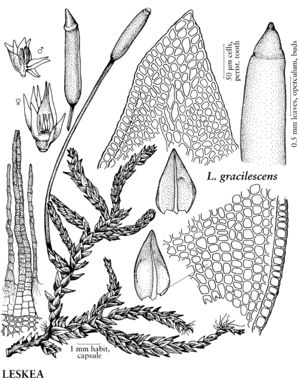Leskea gracilescens
Sp. Musc. Frond., 222, plate 56, figs. 8 – 13. 1801.
Plants dark green or brownish. Stems with branches spreading, ± tightly foliate, not curved at apices. Stem and branch leaves similar. Stem leaves not much longer than broad, 0.6–0.8 mm; apex acute or sometimes narrowly blunt. Branch leaves somewhat crowded, ovate to ovate-lanceolate, ± 2-plicate basally, 0.4–0.5 mm; margins irregularly revolute proximally or beyond, especially when dry; apex acute or sometimes bluntly pointed; costa ending near apex; distal laminal cells 7–11 µm, obscurely bulging-papillose on both surfaces, more noticeably so abaxially. Seta yellow-brown, becoming orange-brown or reddish with age, 0.5–0.8 cm. Capsule reddish, oblong-cylindric, straight to sometimes curved before dehiscence, 1.5–2.2 mm; annulus 1- or 2-seriate; operculum rounded-conic, ± pointed; exostome teeth pale yellowish to brownish yellow; endostome segments as long as exostome teeth. Spores 12–14 µm, very finely papillose.
Phenology: Capsules mature year-round.
Habitat: Base and trunks of hardwood trees, red cedar, soil around tree bases, logs, shingle roofs, rock
Elevation: low to moderate elevations (10-900 m)
Distribution

Man., Ont., Que., Ala., Ark., Conn., Del., D.C., Fla., Ill., Ind., Kans., Ky., La., Maine, Md., Mass., Mich., Minn., Miss., Mo., Nebr., N.J., N.Y., N.C., N.Dak., Ohio, Okla., Pa., S.Dak., Tenn., Tex., Vt., Va., W.Va., Wis.
Discussion
Leskea gracilescens is the most common species of the genus in North America. While the species occurs throughout the United States and Canada from North Dakota to Ontario south to the coastal plain, it is most common in the Midwest where its colonies are often quite large and dense. In the western part of its range, plants with blunt leaves are difficult to distinguish from L. obscura. However, these blunt-leaved forms will have some leaves with plications and revolute margins. If mature capsules with intact peristomes are present, L. gracilescens is easily distinguished from L. obscura by an endostome and exostome nearly equal in length (0.2–0.4 mm) and an operculum that is more pointed than the operculum of L. obscura. The plants of L. gracilescens are rigid.
Selected References
None.
